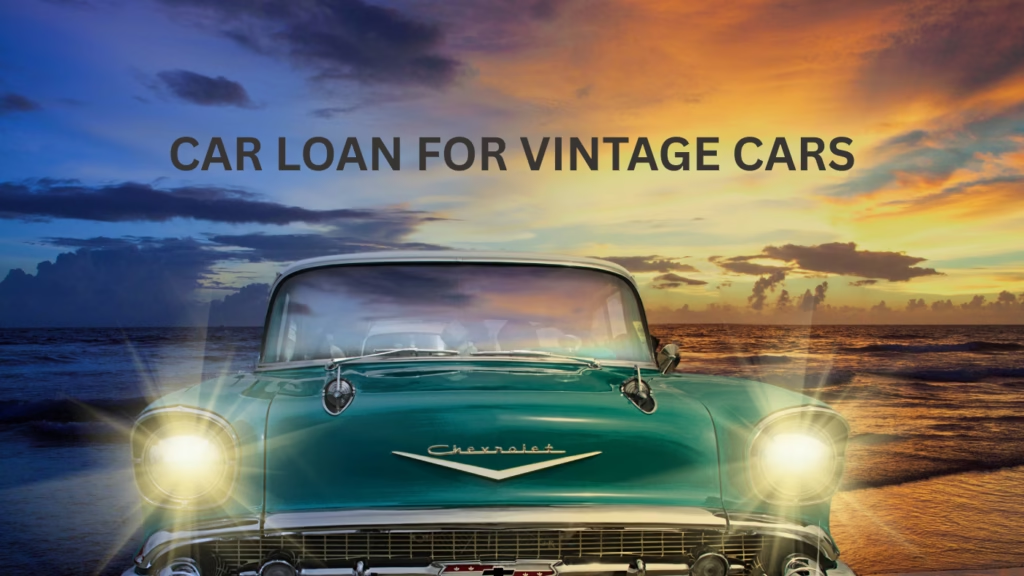Introduction to Car Loan for Vintage Cars Canada
car loan for vintage cars Canada, Owning a vintage car in Canada is a dream for many, whether it’s a sleek classic car loans Canada for weekend drives or a rare collectible that appreciates over time. Securing a car loan for vintage cars Canada can be more complex than financing a new vehicle, as traditional lenders often shy away from older cars due to their age and unique valuation. However, with the right approach, you can find financing options tailored to vintage cars, from personal loans to specialized collector car loans.
car loan for vintage cars Canada, This comprehensive guide explores the ins and outs of financing vintage cars in Canada, offering practical advice, lender insights, and tips to make your dream a reality. For general car loan guidance, the Financial Consumer Agency of Canada provides valuable resources, while platforms like Quick Approvals can help you explore financing options.
What Defines a Classic Car Loans Canada?

A vintage or classic car is typically defined as a vehicle that is at least 25 years old, though definitions vary. Some organizations classify cars from 1948 onward as classics, while others include vehicles from 1900 to 1985. In Canada, there’s no strict government definition, but the 25-year mark is widely accepted. These cars, such as the Chevrolet Camaro, Dodge Charger, or Ford Torino, hold historical and sentimental value, often appreciating in value unlike modern vehicles.
This unique characteristic makes classic car loans Canada different from standard auto loans, as lenders must account for the car’s potential as an investment.
Characteristics of Vintage Cars
- Age: Generally 25+ years old, though some lenders may consider slightly newer models (e.g., from 2000, reaching classic status in 2025).
- Value Factors: Determined by rarity, condition, originality, and historical significance, often requiring expert appraisals.
- Examples: High-value classics include the Plymouth Roadrunner, Chevrolet Chevelle, and Shelby Mustang GT500.
Challenges in Securing Vintage Car Financing Canada
Financing a vintage car presents unique challenges compared to standard car loans:
- Age Restrictions: Most banks, like Scotiabank or CIBC, limit financing to vehicles under 10 years old, as seen on Scotiabank’s Auto Loan page. Older vehicles are considered riskier due to potential maintenance costs.
- Valuation Complexity: Unlike modern cars, vintage car values depend on condition, rarity, and market trends, requiring expert appraisals that can cost hundreds of dollars.
- Limited Lender Options: Traditional lenders often avoid financing vintage cars, pushing buyers toward specialized lenders or alternative financing like personal loans.
- Insurance Requirements: Vintage cars often require comprehensive insurance with agreed-value policies, which can be costly and include restrictions like lay-up periods (e.g., no driving in winter).
Despite these hurdles, several financing options make owning a vintage car achievable.
Financing Options for Classic Car Loan Rates Canada
Several financing options are available for vintage cars, each with pros and cons. Below is a detailed look at the most common approaches:
Personal Loans
Personal loans are unsecured, meaning the car doesn’t serve as collateral, but they often come with higher interest rates (6.99%–35.00% APR, based on market data). Lenders like Coast Capital offer personal loans up to $60,000 with terms from 3 to 120 months, which can be used for vintage car financing Canada. These are ideal if you have good credit but don’t want to risk other assets.
- Pros: No collateral required, flexible use of funds.
- Cons: Higher interest rates, stricter credit requirements (typically 700+ credit score).
Home Equity Loans
Using home equity as collateral can secure lower interest rates, as the loan is backed by your property. However, defaulting risks your home, making this a high-stakes option for classic car loan options Canada.
- Pros: Low rates, long terms (up to 15 years).
- Cons: Risk of losing your home, requires significant equity.
Personal Lines of Credit
A line of credit offers flexibility, allowing you to borrow only what you need up to a limit. This is useful for partial financing or ongoing costs like repairs but may not cover the full cost of a high-value vintage car.
- Pros: Pay interest only on borrowed amount, flexible repayment.
- Cons: Lower loan limits, variable interest rates.
Specialized Classic Car Loans Canada
Specialized lenders focus on collector vehicles, offering tailored terms. These loans often require appraisals but provide competitive rates and long terms (up to 180 months).
- Woodside Credit: Offers loans up to $1,000,000 with terms up to 180 months. For example, a $305,000 McLaren 720S with a 20% down payment at 9.02% APR over 180 months results in a monthly payment of $2,477.36, compared to $4,404.14 with a typical bank loan.
- Financewest: Provides collector car financing in British Columbia, Alberta, Saskatchewan, and Manitoba, with flexible terms for dealers and individuals.
- Hagerty: Connects buyers with lenders specializing in classic car loan options Canada, leveraging their expertise in the collector car market.
Comparison of Financing Options

| Financing Type | Interest Rate Range | Loan Amount | Term Length | Collateral Required | Best For |
|---|---|---|---|---|---|
| Personal Loan | 6.99%–35.00% | $300–$60,000 | 3–120 months | No | Good credit, no collateral |
| Home Equity Loan | 3.00%–7.00% | Varies (based on equity) | Up to 15 years | Yes (home) | Homeowners with equity |
| Line of Credit | 5.00%–10.00% (variable) | Up to $50,000 | Flexible | No/Yes | Partial financing, flexibility |
| Specialized Loan | 4.00%–9.05% | $5,000–$1,000,000 | 24–180 months | Often (car) | High-value vintage cars |
How to Apply for a Classic Car Loan Options Canada
Applying for a classic car loan options Canada involves several steps, tailored to the unique nature of vintage vehicles:
- Identify the Car: Gather details like make, model, year, mileage, and price. For example, a 1970 Chevrolet Chevelle might cost $70,000, requiring a clear valuation.
- Choose a Loan Type: Decide between personal loans, home equity loans, lines of credit, or specialized loans based on your financial situation.
- Compare Lenders: Research lenders like Woodside Credit or Financewest, comparing APRs, terms, and fees. Check if they require appraisals or specific credit scores (often 700+).
- Gather Documentation: Provide ID, proof of income (e.g., pay stubs, tax returns), employment details, and, for specialized loans, a professional appraisal of the car’s value.
- Apply: Submit applications online or in-person. Specialized lenders may offer pre-approval, as seen with Woodside Credit’s quick quote feature.
- Sign Paperwork: Review loan terms, including interest rates, repayment schedules, and fees, before signing.
- Register the Vehicle: Pay provincial registration fees, which vary (e.g., $50–$200 in Ontario).
For general guidance, the Financial Consumer Agency of Canada outlines the car loan application process, though it focuses on newer vehicles.
Requirements for Classic Car Loans Canada
Securing a classic car loan rates Canada often involves stricter requirements than standard car loans:
- Credit Score: Good to excellent credit (700+) is typically required, as lenders view vintage cars as riskier investments.
- Down Payment: A 10–20% down payment is common. For a $70,000 car, this means $7,000–$14,000 upfront.
- Appraisal: An expert appraisal is often mandatory to confirm the car’s value, especially for high-value models like a Shelby Mustang.
- Insurance: Comprehensive coverage with an agreed-value policy is usually required, often with restrictions like lay-up periods (no driving in winter).
Insurance for Affordable Classic Car Loans Canada
Insurance for vintage cars differs significantly from standard auto insurance. Policies are often based on an agreed value, reflecting the car’s appraised worth, which can be higher than market value due to rarity or condition. Companies like Hagerty specialize in classic car insurance, offering features like:
- Agreed-Value Coverage: Ensures you’re compensated for the car’s full appraised value in case of loss.
- Lay-Up Periods: Lower premiums by restricting driving during certain months (e.g., winter in Canada).
- Usage Restrictions: Limits on mileage or driving conditions to maintain the car’s classic status.
Premiums can be higher due to the car’s value, but careful policy selection can make affordable classic car loans Canada more manageable by reducing overall ownership costs.
Tips for Securing Best Lenders for Classic Car Loans Canada

To get the best deal on a classic car loans Canada, consider these tips:
- Research Market Value: Use resources like Hagerty’s valuation tools to understand the car’s worth before negotiating.
- Get a Professional Inspection: Hire a mechanic experienced with vintage cars to check for issues that could affect financing or value.
- Compare Lenders: Look beyond traditional banks to specialized lenders like Woodside Credit or Financewest for better terms.
- Check Credit Score: A score of 700+ can secure lower rates. Review your credit report via Equifax or TransUnion before applying.
- Budget for Total Costs: Include insurance, maintenance, storage, and registration fees in your budget.
- Negotiate Terms: Ask for flexible repayment options or lower fees, especially with specialized lenders.
Platforms like Quick Approvals can help you compare financing options efficiently.
Case Study: Financing a Classic Car Loan Rates Canada
Consider Omar, who wanted to buy a 1970 Corvette for $70,000. He paid a 20% down payment ($14,000) and financed $64,400 (including 12% PST of $6,720) through a specialized lender at 6.90% APR over 7 years. His monthly payment was $968.82, totaling $81,380.88. By choosing a lender familiar with classic car loan rates Canada, Omar secured favorable terms and comprehensive insurance to protect his investment.
Seasonal Trends in Vintage Car Financing Canada
Interest in vintage cars peaks in spring and summer, aligning with car shows and auctions across Canada, such as the Barrett-Jackson Auction. Financing applications may increase during these periods, so applying early can secure better rates. Lenders like Woodside Credit often attend such events, offering on-site pre-approvals.
Q&A: Common Questions About How to Finance a Classic Car in Canada
1. What Are the Requirements for Classic Car Loans in Canada?

Requirements typically include a credit score of 700+, a 10–20% down payment, a professional appraisal, and comprehensive insurance. Lenders may also request proof of income and ID. Specialized lenders like Woodside Credit emphasize expert valuations to ensure the car’s worth.
2. Where to Get a Loan for a Classic Car in Canada?

You can explore specialized lenders like Woodside Credit or Financewest, which offer tailored classic car loans Canada. Traditional banks like Scotiabank may provide personal loans, but these are less common for vintage cars. Check Quick Approvals for financing options.
3. How to Finance a Classic Car in Canada?

Start by identifying the car and its value, then choose a loan type (personal, home equity, or specialized). Compare lenders, gather documents (ID, income proof, appraisal), and apply. The Financial Consumer Agency of Canada offers general loan application tips.
4. What Are the Best Lenders for Classic Car Loans Canada?
Woodside Credit, Financewest, and Hagerty’s lender network are top choices due to their focus on collector vehicles. They offer competitive rates (4.00%–9.05% APR) and long terms (up to 180 months). Compare terms to find the best fit.
5. Are Classic Car Loan Rates Canada Different from Standard Loans?
Yes, classic car loan rates Canada are often lower for specialized loans (4.00%–9.05%) compared to personal loans (6.99%–35.00%), as lenders understand the car’s potential appreciation. However, stricter credit and appraisal requirements apply.
6. Can I Get Affordable Classic Car Loans Canada?
Yes, by choosing specialized lenders with long terms (e.g., 180 months) and competitive rates, or by increasing your down payment to reduce monthly costs. Shopping around and negotiating fees can further enhance affordability.
Conclusion: Making Car Loan for Vintage Cars Canada a Reality
Securing a car loan for vintage cars Canada requires careful planning, but the reward of owning a classic car is worth the effort. Whether you opt for a personal loan, home equity loan, or specialized financing from lenders like Woodside Credit, understanding your options is key. Research the car’s value, compare lenders, and ensure you have comprehensive insurance to protect your investment. For more insights on car loans, visit the Financial Consumer Agency of Canada, and explore financing options at Quick Approvals. With the right approach, your dream vintage car can become a reality, ready to cruise Canada’s roads or shine at the next car show.


